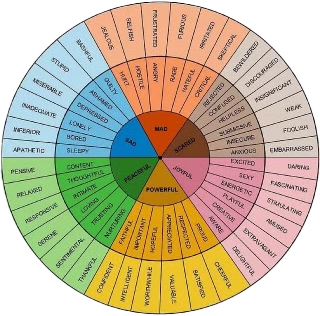What is our fascination with using magic to control our outcomes? Our impatience and desire for things to happen immediately? Do we want things to happen easily? Furthermore, maybe we just want problems to go away? But, maybe it is as simple as looking within and as my friend’s father-in-law stated, “It’s about attitude, gratitude and latitude.” Furthermore, as adults, it is important that we teach our children these three mindsets.


Attitude
Years ago, when teaching my grade four class, recess was over and a group of students came in arguing. The heated words were centred around a fight that occurred in the schoolyard. Here is our exchange:
I asked the angry student what happened, he said, “John made me push him!”
I asked, “He made you push him?”
The response was “Yeah! He made me do it!”
I continued with, “How did he do that?”
The student responded with, “He said something that made me angry.”
“But did he make you hit him?”
“No.”
Gaining the class attention, we continued as a class discussion once everyone settled.
The angry student was still seething in his seat.
I asked the class, “Can anyone get into your head and make you do anything?”
They all looked at me as if a light bulb went off and simultaneously shook their heads.
“No, you are all right, no one can get into your head and make you do anything.”
“So, when someone makes you angry, who is in control of you? The other person or you?”
They all looked at me nodding their heads, then one responded, “We are in control.”
My response was, “Exactly, you control yourself. So, who is responsible for your anger and reactions?”
“We are responsible,” was the response.
Our attitude affects how we perceive our worlds. If we adopt the point of view that we are responsible for our thoughts and actions, then we will perceive ourselves as empowered individuals, not victims. For children who are egocentric, it takes time for them to reason that things are not just done to them but that they take an active role. A relationship with another is a fine dance of give and take.
We can’t start early enough in coaching children to realize that they have a choice in controlling their attitudes and behaviours. Sue Kranz is an excellent parent coach and has distilled Dr. William Glasser’s Choice Theory. Sue’s Who’s Driving Your Car teen edition (endorsed by Dr, Glasser), is an easy-to-read comprehensive guide to choice theory. It states teen edition but it is for everyone. A friend of mine when divorcing her husband kept it by her side and consistently used it to help her get through the stressful time.
Sue’s 6 Things: A blueprint for creating healthy boundaries is a great guide for parents in adjusting their behaviour. As we coach our kids to recognize that they are the only ones that can control themselves and they can’t control others, we need to work on this mindset ourselves. So often as parents, teachers, and grandparents we take on the role of fixers. We need to listen to our own advice, create healthy boundaries and concentrate on how we react. As role models to our kids, they watch us intently and follow our lead.
Here is a link to Sue Kranz’s extensive website where she provides these two phenomenal resources FREE.


Gratitude
Maintaining gratitude is the best way to foster optimism. If we constantly remind ourselves of the blessings and positive aspects in our lives, we focus on what we have, not what isn’t in our lives. We see abundance. We see the glass half full not half empty, as a result, we feel full, not insatiable to seek more. We are content.
When I turned 60 my sister-in-law gave me a set of journals. I began using them to keep a daily gratitude journal. Presently, I take the time before bed to jot down reflections on what I am grateful for on that given day, however, there have been points when I have chosen to make my gratitude list first thing in the morning. Here is a blog that highlights the benefits of morning gratitude journaling.
Whether we are teachers, parents or grandparents, the daily practice of sharing with our kids what we are grateful for in our lives is a great way to model gratitude. It must be noted that sharing thankfulness doesn’t have to be written down. Taking the time to put the sharing in writing allows everyone to go back and easily read and reflect. It also gives everyone a great visual quantifier, “Look at all the things we are grateful to have in our lives!”
Here are a few scenarios that can easily support gratitude sharing:
- At the breakfast table ask your family what they are looking forward to that day and what they will treasure that day.
- While driving the kids to school or picking them up. If you want to change up the lead statement from, “What are we grateful for?” It could be what are you looking forward to doing today or what were three good things that happened in your day?”
- At dinner time. Many of us have gotten away from grace at meals, consider bringing it back to your dinner table and invite family members to add what they are thankful for that day.
- Get a roll of paper used for an adding machine. Write the family gratitude items on the roll. On New Years celebrate by stringing the long roll of grateful items all over your living room.
- Bedtime is a relaxed moment to have these discussions. As mentioned in the links below by reflecting on what we are thankful for at night, we tend to sleep better. It’s giving our minds positive closure.


Latitude
I compare having a latitude mindset to maintaining openness, humility and flexibility. It is keeping our thoughts fluid and open to change or adjustment. Openness also implies that we are curious to ask questions and seek new insights.
Children are naturally very curious and love learning. I’d argue that although many kids like routine and structure, more often than not they are willing to veer off the path to investigate, ponder or try something new. This is where we as adults can take the lead from our children. Many times, as adults, we get railroaded in our agendas which are packed with tasks. Our lists of ‘to-dos’ can be so extensive creating stress that we end up in a knot of stress.
In my business parable the Executive Gardener and the Fairy, Frank the main character is caught in one of these stress knots. He concludes the following: Undo Knots! Humility begets flexibility begets flow.
Take a look:
As previously mentioned, although children are curious, they do like routine and depending on their personalities and age they can be rigidly stubborn. This can trigger anxiety for both the child and adult. Here is a great blog by Katie Hurley that offers ways to help kids get out of a rigid mindset.
Latitude is making a commitment to remaining open and positive. It’s exposing our children to a variety of experiences. It is also about being open and flexible role models. Fostering latitude is critical for us all, especially in these chaotic times when we seek security in stability, control and the known, we need to remember to keep open-minded to new ideas and experiences.
Attitude, gratitude, and latitude weave together to compromise the essence of our personal magic powers. When we choose to embrace these positive thoughts and behaviours, we are building resilience. Metaphorically engaging in an attitude, gratitude and latitude mindset, we are waving our own wands that magically transform negativity and problems into positive perspectives and solutions.
When I grew up there were two shows that fascinated many of us, Bewitched and I Dream of Jeannie as they featured two women with magical powers that could change anything. Recently, while with my dear friend Tara, we joked that we wish we had magic wands that we could wave and presto, our problems, (albeit, mostly first world problems) would be gone.
This conversation inspired the following story Wand it be Gone! It is a story about Willow and Whitney, two girls that teach each other to maintain attitude, gratitude and latitude. It is through this growth mindset that they are able to wand their challenges gone! Take a look at the PDF which you can read to your children Use it as a basis for discussion on the topic. I have left spaces so that your child can illustrate the story. I invite you to share their drawings and advice on keeping an attitude, gratitude, latitude mindset, which with your permission, I will post on the website.


Dig Deeper
- https://www.askdrsears.com/topics/parenting/discipline-behavior/morals-manners/5-stages-moral-growth-children/
- https://www.npr.org/sections/health-shots/2018/12/24/678232331/if-you-feel-thankful-write-it-down-its-good-for-your-health#:~:text=Studies%20have%20found%20that%20giving,and%20bolstered%20generosity%20among%20adolescents
- https://positivepsychology.com/benefits-of-gratitude/https://autismawarenesscentre.com/ten-ways-to-increase-your-childs-ability-to-be-flexible/







[…] Next Post […]